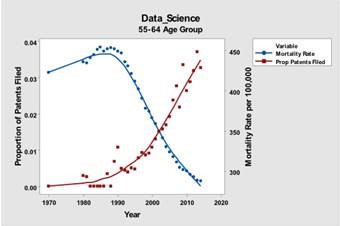My goal was to create a visualization that shows how patent filings in the nine patent categories listed below correlate to changes in the cancer mortality rate over time for different age groups.
Click here to access the visualization.
A negative correlation between patents filed and cancer mortality rate is an indicator that increased research in that category may reduce cancer mortality. The following categories had a strong negative correlation between patents filed and cancer mortality for all age groups except 85+:
- Diagnostic_and_Surgical_Devices
- Data_Science
- DNA_RNA_or_Protein_Sequence
The age group where the negative correlation is the strongest among these three categories is 55-64 years. Increasing funding in these areas may lead to further decreases in cancer mortality, especially in the 55-64 age group.
Two additional categories had strong negative correlations for all age groups except 75-84 and 85+.
- Model_Systems_and_Animals
- Cells_and_Enzymes
Increasing funding in these areas may lead to further decreases in cancer mortality for patients under 75. It is not known if 75 and over patients used medical procedures derived from these two categories at lower rates than patients under 75, which could explain the lack of benefit.
Four categories showed little or no negative correlations.
- Food_and_Nutrition
- Drugs_and_Chemistry
- Radiation_Measurement
- Other_and_Preclassification
Funding in these areas did not correlate well to decreased cancer mortality
When you click on any of the above links within the Tableau visualization you will be leaving the United States Patent and Trademark Office (USPTO) Open Data Portal. The USPTO does not necessarily endorse the views expressed or the facts presented on this site. Further, the USPTO does not endorse any commercial products that may be advertised or available on this site. You may wish to review the privacy notice on those sites since their information collection practices may differ from ours.
